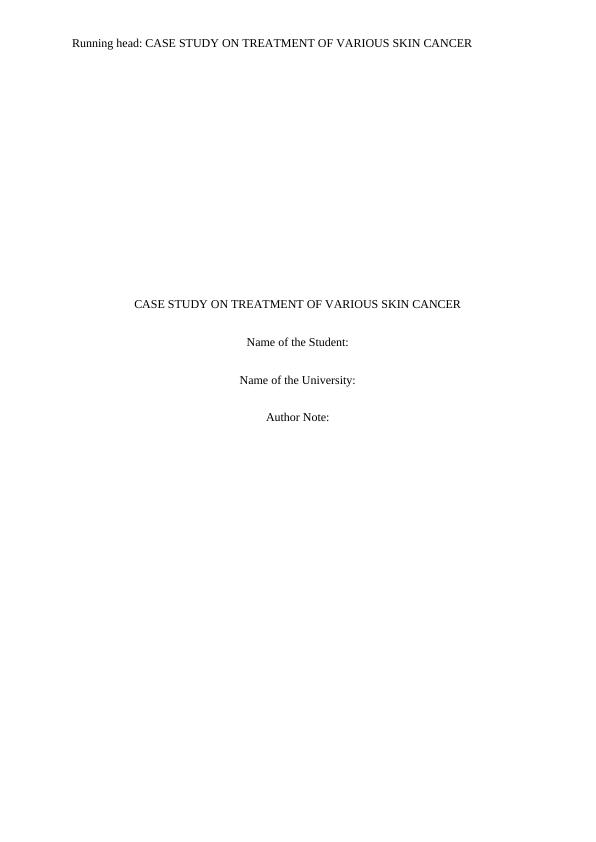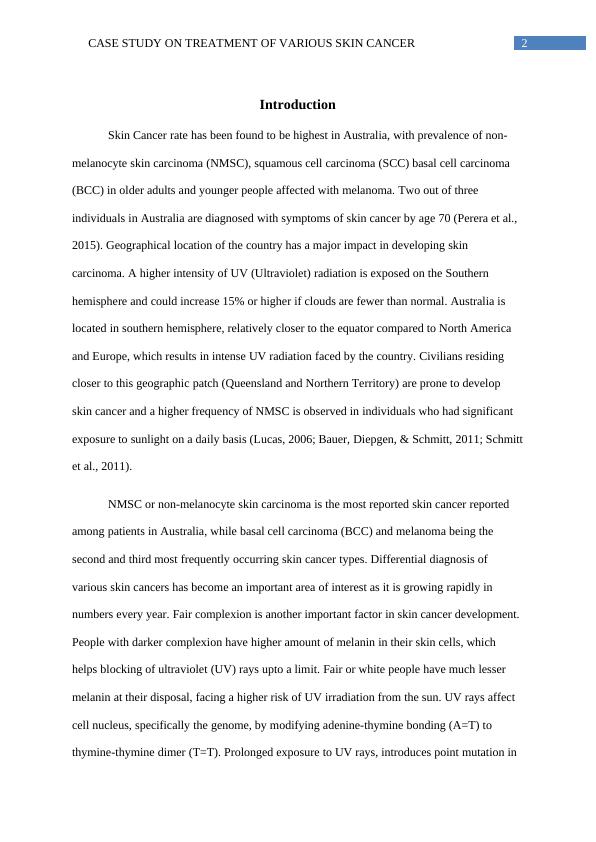Case Study on Treatment of Various Skin 2022
Added on 2022-10-19
13 Pages3929 Words9 Views
Running head: CASE STUDY ON TREATMENT OF VARIOUS SKIN CANCER
CASE STUDY ON TREATMENT OF VARIOUS SKIN CANCER
Name of the Student:
Name of the University:
Author Note:
CASE STUDY ON TREATMENT OF VARIOUS SKIN CANCER
Name of the Student:
Name of the University:
Author Note:

1CASE STUDY ON TREATMENT OF VARIOUS SKIN CANCER
Table of Contents
Introduction................................................................................................................................2
Discussion..................................................................................................................................3
Conclusion..................................................................................................................................9
References................................................................................................................................11
Table of Contents
Introduction................................................................................................................................2
Discussion..................................................................................................................................3
Conclusion..................................................................................................................................9
References................................................................................................................................11

2CASE STUDY ON TREATMENT OF VARIOUS SKIN CANCER
Introduction
Skin Cancer rate has been found to be highest in Australia, with prevalence of non-
melanocyte skin carcinoma (NMSC), squamous cell carcinoma (SCC) basal cell carcinoma
(BCC) in older adults and younger people affected with melanoma. Two out of three
individuals in Australia are diagnosed with symptoms of skin cancer by age 70 (Perera et al.,
2015). Geographical location of the country has a major impact in developing skin
carcinoma. A higher intensity of UV (Ultraviolet) radiation is exposed on the Southern
hemisphere and could increase 15% or higher if clouds are fewer than normal. Australia is
located in southern hemisphere, relatively closer to the equator compared to North America
and Europe, which results in intense UV radiation faced by the country. Civilians residing
closer to this geographic patch (Queensland and Northern Territory) are prone to develop
skin cancer and a higher frequency of NMSC is observed in individuals who had significant
exposure to sunlight on a daily basis (Lucas, 2006; Bauer, Diepgen, & Schmitt, 2011; Schmitt
et al., 2011).
NMSC or non-melanocyte skin carcinoma is the most reported skin cancer reported
among patients in Australia, while basal cell carcinoma (BCC) and melanoma being the
second and third most frequently occurring skin cancer types. Differential diagnosis of
various skin cancers has become an important area of interest as it is growing rapidly in
numbers every year. Fair complexion is another important factor in skin cancer development.
People with darker complexion have higher amount of melanin in their skin cells, which
helps blocking of ultraviolet (UV) rays upto a limit. Fair or white people have much lesser
melanin at their disposal, facing a higher risk of UV irradiation from the sun. UV rays affect
cell nucleus, specifically the genome, by modifying adenine-thymine bonding (A=T) to
thymine-thymine dimer (T=T). Prolonged exposure to UV rays, introduces point mutation in
Introduction
Skin Cancer rate has been found to be highest in Australia, with prevalence of non-
melanocyte skin carcinoma (NMSC), squamous cell carcinoma (SCC) basal cell carcinoma
(BCC) in older adults and younger people affected with melanoma. Two out of three
individuals in Australia are diagnosed with symptoms of skin cancer by age 70 (Perera et al.,
2015). Geographical location of the country has a major impact in developing skin
carcinoma. A higher intensity of UV (Ultraviolet) radiation is exposed on the Southern
hemisphere and could increase 15% or higher if clouds are fewer than normal. Australia is
located in southern hemisphere, relatively closer to the equator compared to North America
and Europe, which results in intense UV radiation faced by the country. Civilians residing
closer to this geographic patch (Queensland and Northern Territory) are prone to develop
skin cancer and a higher frequency of NMSC is observed in individuals who had significant
exposure to sunlight on a daily basis (Lucas, 2006; Bauer, Diepgen, & Schmitt, 2011; Schmitt
et al., 2011).
NMSC or non-melanocyte skin carcinoma is the most reported skin cancer reported
among patients in Australia, while basal cell carcinoma (BCC) and melanoma being the
second and third most frequently occurring skin cancer types. Differential diagnosis of
various skin cancers has become an important area of interest as it is growing rapidly in
numbers every year. Fair complexion is another important factor in skin cancer development.
People with darker complexion have higher amount of melanin in their skin cells, which
helps blocking of ultraviolet (UV) rays upto a limit. Fair or white people have much lesser
melanin at their disposal, facing a higher risk of UV irradiation from the sun. UV rays affect
cell nucleus, specifically the genome, by modifying adenine-thymine bonding (A=T) to
thymine-thymine dimer (T=T). Prolonged exposure to UV rays, introduces point mutation in

3CASE STUDY ON TREATMENT OF VARIOUS SKIN CANCER
the DNA structure, which leads to malfunction of proteins and abnormal proliferation of skin
cells or higher prurific response due to invasion of infectious agents. Several methods have
been developed to identify skin cancer types and propose treatment accordingly. This report
briefly discusses about various types of lesions formed in skin cancer and postulated
treatments in practice with associated effectiveness.
Discussion
Human skin is the largest organ of the body, which covers the entire skeletal structure,
protecting against UV rays, heat shock, allergens and infectious microorganisms. Older
individuals are highly affected by non-melanocyte skin carcinoma (NMSC), which is
independent of action of the melanin pigment. NMSC are found to be initiated at the basal or
squamous cells of the epidermis and hence is a typical condition of basal cell carcinoma
(BCC) and squamous cell carcinoma (SCC). Basal cells are circular cellular structures found
on the outer layer of epidermis. Basal cell carcinoma has significant characteristic lesion
formation on the head or neck, which enables distinguishing these from squamous or other
forms of skin carcinoma.
Four major subtypes of BCC are, nodular, superficial, morpheaform, infiltrative and
micronodular. Nodular BCC is the most frequently occurring subtype of basal cell carcinoma,
occurring primarily on the facial part that is exposed to direct sunlight. A red or pink colored
spherical wart or white lump of mass are found to be resulting symptoms of this disease.
Blood vessels are often seen on the surface of the swollen lesions. Superficial BCC forms
generally on the central part (trunk, legs, arms) of human body. Morpheaform BCC are found
primarily in head and neck area with a flatter, whitish or yellow aggregation of rash. In some
cases, morpheaform BCC could resemble a normal scar, which makes it harder to
differentiate during diagnosis. Additionally, morpheaform BCC spreads rapidly than nodular
the DNA structure, which leads to malfunction of proteins and abnormal proliferation of skin
cells or higher prurific response due to invasion of infectious agents. Several methods have
been developed to identify skin cancer types and propose treatment accordingly. This report
briefly discusses about various types of lesions formed in skin cancer and postulated
treatments in practice with associated effectiveness.
Discussion
Human skin is the largest organ of the body, which covers the entire skeletal structure,
protecting against UV rays, heat shock, allergens and infectious microorganisms. Older
individuals are highly affected by non-melanocyte skin carcinoma (NMSC), which is
independent of action of the melanin pigment. NMSC are found to be initiated at the basal or
squamous cells of the epidermis and hence is a typical condition of basal cell carcinoma
(BCC) and squamous cell carcinoma (SCC). Basal cells are circular cellular structures found
on the outer layer of epidermis. Basal cell carcinoma has significant characteristic lesion
formation on the head or neck, which enables distinguishing these from squamous or other
forms of skin carcinoma.
Four major subtypes of BCC are, nodular, superficial, morpheaform, infiltrative and
micronodular. Nodular BCC is the most frequently occurring subtype of basal cell carcinoma,
occurring primarily on the facial part that is exposed to direct sunlight. A red or pink colored
spherical wart or white lump of mass are found to be resulting symptoms of this disease.
Blood vessels are often seen on the surface of the swollen lesions. Superficial BCC forms
generally on the central part (trunk, legs, arms) of human body. Morpheaform BCC are found
primarily in head and neck area with a flatter, whitish or yellow aggregation of rash. In some
cases, morpheaform BCC could resemble a normal scar, which makes it harder to
differentiate during diagnosis. Additionally, morpheaform BCC spreads rapidly than nodular

End of preview
Want to access all the pages? Upload your documents or become a member.
Related Documents
Skin Cancer: Types, Causes, Treatment and Preventionlg...
|8
|1847
|316
Treatment and Characteristics of types of Skin Cancerlg...
|7
|1302
|62
Skin Cancer Treatment Essay 2022lg...
|4
|1491
|15
Environmental Risk Assessment for Skin Cancer in Outdoor Workerslg...
|10
|2357
|118
